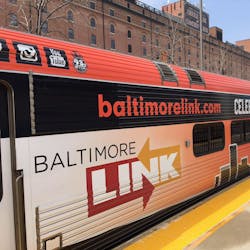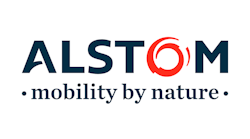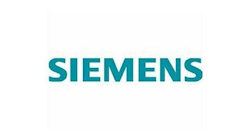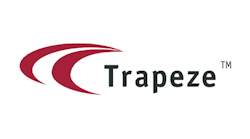MTA is a statewide agency and a division of the Maryland Department of Transportation. MTA operates local and commuter buses, light rail, the metro subway, Maryland Area Regional Commuter rail service, paratransit service, and manages the Taxi Access system. MTA also directs funding and statewide assistance to locally operated transit systems throughout the state.
Administrator and CEO Paul Comfort, is appointed by the secretary of transportation and confirmed by the state’s governor and is part of the executive branch of the Maryland government. There is no board of directors, as is usually the case with transit systems. “I’m the administrator of our statewide agency, but I’m CEO of Baltimore city’s transit system,” he explained.
MTA serves Baltimore County, Baltimore city and Anne Arundel County and have about 2 million people in the service area.
“I think that’s why we’re able to do big things here, because I don’t have to answer to a whole bunch of politicians who have their own competing interests,” Comfort said. “I still get it … every week I get a call from a politician who says, ‘Paul, my grandmother has a bridge game over here on Thursdays, can we put a bus stop there in front of that house?’
“No sir, we’re not going to do that. That’s how the system got so bastardized in the first place – 50 years of that.”
Another big difference, MTA has a dedicated funding source. The state has a transportation trust fund. The state highway, port, airport and transit share the money that’s divided out by the general assembly, governor and secretary.
Comfort described it as, “This is the pinnacle of transit in Maryland.
“To me … it’s the place where I could have the most influence for good. I really want to use transit as a tool, as a mechanism, to improve people’s lives.”
Rail Asset Management
Like other agencies of its age and size, MTA is facing aging infrastructure. The subway system is 30 years old, light rail is 25 years old. Comfort said they had to make some dramatic fixes because they were very close to having significant issues.
“There are all these things we want to do that are great – BaltimoreLink, Purple Line, maglev, but there is one thing we cannot do and that is have a derailment or some significant safety failure,” he said. “Everybody needs to be focused on that.”
MTA Director MARC Train and Commuter Bus Services Erich Kolig talked about what they’re doing to update the MARC fleet. He said they just bought 54 new bi-level cars from Bombardier, which are now in service to help with capacity problems, and they have a third of the fleet going through an overhaul with Bombardier. “They’re going to come back out of that with passenger amenities and a refresh of all the safety systems and running gear,” he said.
They have the MARC 2s, single-level cars that they’re gradually fading out of service, which are about 35-45 years old and at the end of their lifecycle. The MARC 3 vehicles are about 20 years old now and are the ones going through the overhaul. The MARC 4s are the brand new cars.
With a lot of bike service, particularly on MARC’s weekend service, they’ve taken one of the single-level cars and converted the interior so there are full-size bike racks on one side, which can carry up to 23 bicycles at a time. They have four of those cars so that there can be bike service on every train on the weekend.
“It has been fantastically well received,” said Kolig. ‘We won an award for that from the Washington Area Bike Community Association.”
They’ve installed new bike racks at most of the stations and they’re installing bike racks on all of their trailer cars so they can provide bike service on a week-day basis, as well. Kolig said, “We’re taking out a few seats and we’re putting in a couple bike racks per car and that way, on a full-size train, we’ll be carrying between 12 and 16 bikes.
“That will be phased on to all our lines and all of our weekday service.” He continued, “We’ll have full bike compatibility that meets Maryland’s goals for bike initiatives.”
And while there were questions about taking out seating to fit bikes, he said the new bi-level cars have 20 percent more seats than a single-level car so they can meet the needed capacity.
They have eight new Tier 4 locomotives on order from Siemens. Kolig said the engines are capable of operating at 125 mph and will help them in providing clean, efficient, reliable service.
“Within the next five years, most of our fleet will be 10 years old or younger,” Kolig said.
Metro is also at the end of its lifecycle and that is a $600 million vehicle replacement project. The light rail is at its midlife point. The light rail vehicles are all being refurbished, a $150 million project with Alstom. “We have our first vehicle already back and the next two on the way,” said Comfort. “Pretty much all of our steel wheel stuff is going to be brand new in a few years or refurbished.”
BaltimoreLink
The big project that needed to be taken on at MTA was the one that transported the majority of its customers: the bus service. About 385,000 people a day ride MTA and about two-thirds of that ride the bus. Comfort said of their bus service, “It was terrible, just terrible. It was broken.”
MTA Director Office of Planning and Programming Kevin Quinn Jr., AICP, went to Comfort and told him they had recently done a study called the Bus Network Improvement Project (BNIP). It had taken two years to complete, but nothing was ever done with it.
The BNIP was a series of origin-destination data, traffic, ridership, land-use, demographic data and comments from riders. As part of the process, they had received more than 4,400 comments through three robust phases of public outreach. Quinn added, “About 1,000 of those came from our operators, who know the system better than anyone else.”
“We took a look and it was the basis of all kinds of data,” said Comfort. “It was awesome.”
The BNIP was the basis for the undertaking of BaltimoreLink, a complete overhaul and rebranding of MTA’s core bus system.
The system was designed to take everyone to downtown to the central business district. There are 145,000 jobs in the downtown area, but there are another 600,000 jobs in the region around that.
There are a couple big cities north of Baltimore, Towson and White March. To go from White Marsh to Towson, you have to go to downtown Baltimore, transfer to another bus, and then go back north. It’s a 90-minute or more ride. To drive the 9 miles between the cities, it’s a 20-minute drive.
“If you’re not going downtown, you shouldn’t have to,” Comfort said.
A lot of the routes are also too long because bus stops had been continually added and they would get stuck in the heaviest traffic.
Comfort added, “You could jog faster than you could ride our bus in a lot of the areas. I’m not kidding; it was terrible.”
“Buses were laid out 50 years ago, the subway 30, the light rail 25 and never the twain shall meet,” said Comfort. “They laid them out as separate systems.”
BaltimoreLink is a chance to link MTA’s modes and link people to where jobs are today, to where the places people want to go. The network redesign is about efficiency and reliability.
Governor Larry Hogan announced BaltimoreLink in October, 2015. MTA then embarked on three different phases of public outreach, completing the final phase in January, where there were 14 public hearings throughout the region.
In April, MTA released the fourth and final network design.
A rebranding is part of the project. The buses are mismatched with four different color designs and the bus stop signs aren’t very informative unless you know what you’re doing.
New bus stop signs have the route number, where it’s going, how often it runs and additional MTA information on the back. They wanted clear, easy-to-read information.
As for route design, 20 of the MTA’s 65 routes had 70 percent of the ridership. They looked at the “heavy haulers” as the lines they really needed to improve. They paired them down to 12 main routes, called CityLink. It’s a high-frequency service, coming every 10 to 15 minutes all day long.
Comfort explained, “We’re going to do the management there by headway management instead of by timepoint management.” They have Trapeze software and they recently started testing it out for headway management. The service is going to be like pulse in and out of the city and connect with light rail and the subway.
“When you do transit right, you can make someone’s day. When you do it wrong, you can ruin their day, or more, you can cost them their job,” said Comfort. “We’re never going to have the most passengers; we’re not New York or LA, but we can be No. 1 in safety, No. 1 in efficiency.”
June 18 is the day everything will change. Quinn said, “We’ve got to do it overnight. All the routes, all the pieces are really connected. It’s like a body; you can’t just fix the arm.”
New bus stop signs have been going up since spring, with canvas bags placed over them. Overnight, the canvas bags on the 5,000 bus stop signs will be taken off.
While BaltimoreLink is about improving the bus system, it’s also about taking a multi-modal approach to system improvement. When all is said and done, there will be bikeshare at 11 different metro light rail stations, in addition to car share.
The project will include 200 new shelters and several big transit hubs. The biggest hub is at the west Baltimore MARC station. A sizeable parking lot that has about 100 spaces is going to be turned into a bus hub that’s going to have real-time signage, shelters, a bathroom for operators and layover space.
Riders will be able to transfer in an easy, comfortable way, but also it pulls off a lot of stops and consolidates it in one really, nice facility.
The focus in spring was outreach. Quinn said they got a great “lesson learned” from Metropolitan Transit Authority of Harris County (METRO): an information bus. It’s a bus that goes out on the current routes. Passengers ride for free and on board is staff handing out materials about how the route will change and available for answering questions. “It’s really those conversations with passengers that are the most important.”
MTA has 30 to 40 transit ambassadors that went through training to go on the information bus. As it gets closer to launch date, they ramp up the efforts.
As of April the MTA had been about halfway through training its operators on the new system. They do 30 at a time, for a 3-day class. The operators are taken out of revenue service and paid to get trained on all of the routes out of the garage they work at.
They’ve also videotaped every route and put them on YouTube so the public can see the new routes, and so the operators can see them. As part of the training process, MTA has installed four computers at each of the divisions so the operators all have access.
Gregory Spencer Jr., a 12-year operator out of the MTA Eastern Division, said, “They had people come out to the operators and let us know exactly what’s going on throughout the process … get our input and actually take our suggestions. A lot of our suggestions actually made it to the final cut.”
Spencer also wanted to mention the infrastructure changes that are a part of BaltimoreLink, are already having an impact on service. “The dedicated bus lanes, they have already made a tremendous impact on our service,” he said. “Now we can get through downtown, Lombard Street, you don’t get bogged down in traffic; you can maintain your schedule.”
[[[Sidebar: EcoSeal]]]
The MTA Bus Maintenance EcoSeal Program utilizes the water-based spray and sealant that prevents the spread of germs and it increases cleaning efficiency.
David Varner, director bus maintenance, and Jose Barreda, superintendent Bush Division, talked about the benefits they’ve seen since utilizing it.
The MTA bus fleet is more than 700 buses and currently it takes 16 hours to clean a bus. Cleaning the buses that have been treated with EcoSeal drops that time to 8 hours. Calculating it out, they see the MTA will save $60 per bus or more than $40,000 across the fleet.
As of April, the buses at the Bush Street Division were treated and the Eastern Avenue buses were undergoing treatment. The Northwest and Kirk Avenue Divisions would then be next for the program.
[[[end sidebar]]]
Purple Line
The Purple Line, a 16.2-mile light rail line connecting to Washington Metropolitan Area Transit Authority stations, is in the planning stage but delays threaten the project.
Last August, merely days before closing on a $900 million Federal Transit Administration grant, U.S. District Court Judge Richard J. Leon required revised ridership numbers. The concern was the impact of declining ridership on Metro and what impact that would have on the ridership estimates for the Purple Line as one in four passengers are expected to transfer to the D.C. system.
In November the judge was given an updated report regarding ridership estimates but since receiving the report, Leon has yet to respond. If delayed past the end of the fiscal year, it could lose the federal funding that has been set aside.
With no time limit for the judge to rule, money could run out. “It’s not fair to have that money run out when this project would help out so many people,” Comfort said.
“It’s well over a hundred million dollars that’s been spent and it would take a lot of money just to shut it down at this point,” he said. “We have obligations. We could still get right back on schedule if he gives us a ruling. We’re doing borings, the engineering, the final design layout, meeting with communities, doing the public art designs – all the stuff that has to be done.”
It was reported that Purple Line Transit Partners CEO Rob Chappell said the team is committed to the project, even though officials have estimated costs increase by $13 million for every month of delay.
Maintaining a Safe System
Comfort said in the city that has led the nation in the rate of shootings, the MTA has the lowest number of Part 1 crimes out of the top 12 transit systems in the U.S. “Safety-wise, we’re there,” he said. “That doesn’t happen by accident.”
A successful program MTA Police, Chief of Police John Gavrilis talked about was the for its Zone Enforced Unified Sweeps (ZEUS) program. He said, “We took a look at how our deployment occurred and how we could tap our resources so we could create a very high-visible deployment to address crime and to target harden our facilities from any terrorist attacks.
“We believe that’s one of the strategies that has really contributed to our reduction in crime. That along with the Compstat process, gathering data and being able to look at 28 days, 7 days, a year ago and in one day. What our trends could be and making our resources to address those trends.”
Gavrilis said they work with the local police department, state and feds and have more than 41 MOUs, memorandum of understanding, which gives concurrent jurisdiction that allows those local, state and federal officers to come aboard on stations and platforms.
“We have a program called law enforcement onboard program,” explained Gavrilis. “We have more than 200 police officers who ride the MARC system free, however, they’re our eyes and ears on the MARC system.
“We’re able to put out data to them, what’s important to us, and then they report back to us on a near-daily basis of issues or incidents or information or intelligence that we can use to leverage our resources for deployments.”
MTA Police also utilize plenty of the latest technology to help keep the system safe. “Technology is a force multiplier,” said Gavrilis. “We have more than 2,000 cameras that MTA has system-wide in all of our conveyances: bus, light rail, metro. They all have cameras. Which is a huge deterrent in itself.”
They have smart cameras by Skyline Security Co. Ltd. that can recognize acceptable and unacceptable behavior.
The MTA is also tied locally to the city, so they can also see what the city sees in its cameras. With the state, MTA Police have MView, to see the state’s cameras, as well. The coordination is a cost-effective solution that has improved MTA’s efficiency.
The biggest challenge is maintaining order during school, when school lets out. Gavrilis said, “We have 20-some thousand children who converge.” Comfort said, “27,000 school kids a day ride our system.”
At some hubs, there are 5,000 to 6,000 students within a 2-hour time period or less. “Ninety-nine percent of those students are very orderly,” said Gavrilis. “But still, when you get a whole lot of people, a whole lot of kids in one area, you have to be able to direct them. That’s probably the biggest challenge we have to ensure the safety not only of the students, but also the other riding public.”
Communication in the New Era
There’s been a heavy emphasis on social media, in part because of the age of a lot of the MTA’s customers. With so many school children, they have a heavy presence where the kids are, on Snapchat and Instagram.
With BaltimoreLink, such an immense change to the system, they’re messaging a route every single day for several months: how it’s changing, from what the current alignment looks like to what it will look like in the new system.
They’ve also been letting customers know about the Information Bus that’s been going around. It rides every single route and if people jump on that bus, they get a free ride.
The MTA also has its own FM radio station that launched in 2016, 93.5 FM. It’s in Baltimore and in the D.C. area, as well as other parts of Maryland. “It’s a fantastic vehicle to constantly let people know about what’s going on,” said Ryan Nawrocki, senior director of communications and marketing.
It was about 15 months out to the launch of BaltimoreLink when Nawrocki came on board at MTA as its senior director of communications and marketing. At the time there wasn’t an adequate presence on social media so they quickly ramped up the social media presence, going from four platforms to 12. They also went to more consistent posting, to at least three posts every day, including more visuals and video.
To increase their presence, they also started utilizing paid content on several platforms. Nawrocki said, “The way that Facebook and a lot of it is structured, the model there is they want you to buy ads.
“You want to put your content out in front of as many people as possible; you have to have paid campaigns running,” he said. As a result, in the past year they’ve quadrupled the audience on Facebook and doubled the audience on Twitter.
There’s a team of three that are primarily responsible for social media engagement, responding to the comments and questions. “That’s why Ryan’s up until 2 in the morning,” Comfort joked. “I’m up pretty late,” he agreed.
As some of the platforms, like Facebook, recognize auto replies that count against the algorithm of feeding your posts to people, they don’t ever use complete automation. Though there is a level of automation with some of it, such as some of the rider alerts will automatically populate to the Twitter feed.
Speaking of automated messaging, Nawrocki said, “a lot of that automated stuff, it’s good, it does serve a purpose for a certain audience, but it doesn’t really allow you to grow your audience.”
Making social media more customer friendly as opposed to passive engagement, is the focus. “Not everyone is doing that in the industry,” he said. “If they see there’s a more interactive, more engaged presence, other people will come to your page.”







